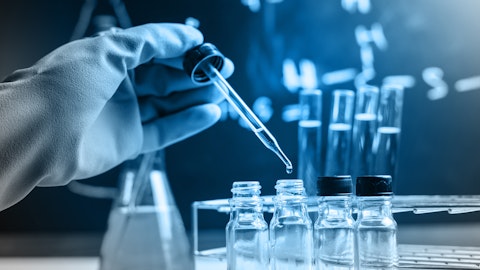In essence, the deep learning gives new suggested clones to go after. For example, in this block here, in the middle, you can see a green box and highlighted in light blue are clones that were suggested to further test the characters. Before we do so, we established one last quality filter. We use a structure based in silico developability filter. This filter and set of tools allow us to create homology models on any given sequence. And that allows us to use our 3D and homology models to calculate some developability properties. And therefore, we can use these to, very efficiently in cost and in time, filter out and focus on the most promising candidates. And so AI gives us additional high affinity and highly developable antibody sequences.
So looking back on this spot, we can go from the lineages that are boxed here to feed that into AI, and AI suggests to focus on maybe some additional columns [ph], which are highlighted in the green in the box lineages. So now we have a systematic way to continue to select antibodies. And one thing I’ll point it tells us to perhaps focus on some rare variants down at the bottom. These are variants perhaps, we would not have known to look or would have prioritized against because of resources. But now we have a way to explore this space in a guided manner. And so OmniDeep provides these new insights specific to these non-obvious insights on our immune repertoires for our projects. So OmniDeep is where the power of Biological Intelligence meets AI.
We study and embed Biological Intelligence into machine learning, helping us assist in discovery and optimization. We’re offering access to our partners’ new workflows, for example, this large-scale discover workflow and also the various optimization tools in OmniDeep for their existing campaigns. We are trying to offer in OmniDeep the best of our in vivo and in silico capabilities. Thank you, and next will be Doug.
Doug Krafte: Thanks, Bob. So Bob and Bill just did a great job introducing some of the innovations that we have in our technology platform. What I’d like to do now is move on to the Ion channel opportunity to that’s coming out of the development of those innovations and some really interesting things that we have ongoing. So for those of you not familiar with this space, I’m just going to walk you through what Ion channel is. Everyone, I think is familiar with ions. These are atoms or molecules that are charged, sodium potassium when we go to our physicians, and we get our blood chemistries done, we measure all these things. Every cell needs to manage the composition and the concentrations of ions across cell membranes to maintain health and a normal status and avoid disease.
And it does that by expressing ion channel proteins primarily. And what these proteins are. They’re shown on the cartoon on the right-hand side of the slide that you see. The green is the protein and the little orange circle spheres are the ions going through, depicted to go through. And you can see on the right-hand side, the ions going through that one channel. And it’s a big hole, and that’s a channel through the membrane. Hence the name ion channel proteins for this class. And when those ions flow through, they can translate signals, they can change a lot of properties and cells. It results in very small currents and that’s what’s shown in the animation on the bottom there that you can see. Those downward blips of deflection are one protein, one ion channel opening at a time and also very, very small electrical current coming from that.
And with sophisticated technologies, we can report these currents and do things in the lab with them. So when you look at single proteins and ion channel function, it’s really cool. If you’re into science that’s a fun thing to do, but why should anybody else care, right? Well, they should care because channels are important in both health and disease. And they’re involved in everything we do, everything, almost every function in the body. We’ve picked some examples here to show you on the left. Ion channels regulate the heartbeat. They regulate movement through muscle and their function. All of our senses, vision, smell, touch hearing. Clay Armstrong, who is an eminent biophysicist and researcher in the field made the statement when he was receiving the Albert Lasker Award.
He said, I think that ion channels are the most important single class of proteins that exist in the human body or any body for that matter. Now Clay Armstrong obviously is biased because he worked on ion channels, but it really is true. They’re everywhere, and you can only get a lot of physiology, biology and disease by studying these proteins. And they’re one of the largest drug classes as a result of that because when ion channels don’t work, a lot of things go awry. We’ve spent at OmniAb many, many years now developing what we believe is one of the industry’s most experienced ion channel teams of drug discovery experts. We have decades of experience that have primarily been applied in small molecules, but now we’re leveraging that in the antibody space.


